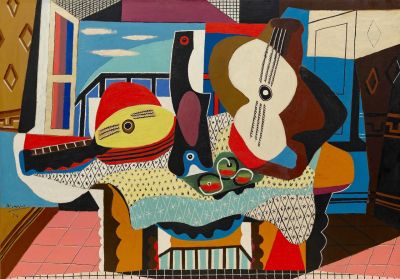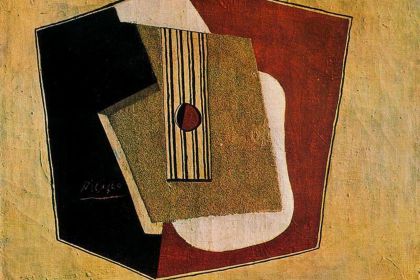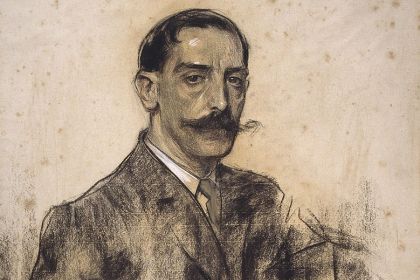Classical Guitar
5 flamenco guitar pieces of Joaquín Turina as performed by the best guitarists of the 20th century

Mandolin and Guitar by Pablo Picasso
Joaquín Turina is considered to be one of the most influential Spanish composers of the 20th century, especially for his contribution to the development of musical nationalism and diverse musicological activity. His compositional style was an organic mix of Spanish folk songs and dances with a touch of French impressionism which, in many aspects, continued the trends of his fellow countryman Isaac Albeniz.
A special role in Turina's output is held by his classical guitar works which have gained immense popularity since their writing in the 1920s and are still holding an important place in the repertoire of classical guitarists. Turina himself did not play the guitar, and his efforts to compose for the instrument were largely driven by Andres Segovia, a guitarist whose career was aimed at restoring the former popularity of the classical guitar.
In 1923, Turina finished Sevillana (Fantasia)—his first work for the classical guitar based on fiery Sevillanas, or the folk dances that originated in Sevilla, the very center of Andalusia, where the composer was born. The piece begins and ends with strummed chords, emphasizing the swiftness of these dance movements, while the middle section is filled with lyrical motifs to reveal the poetic harmony of the genre. In the same year, Segovia himself premiered Sevillana at the Sociedad de Cultura Musical in Madrid, and his contribution to the composition process was noted by Turina in the manuscript with the words, "Al maravilloso guitarrista Andrés Segovia con admiración y cariño".
Listen to Joaquín Turina's Fantasia Sevillana performed by Andrés Segovia:
Fandanguillo —Turina's next solo guitar work rooted in the centuries-old tradition of flamenco dancing was completed in 1925. In addition to strummed guitar patterns and high-speed melodic passages in the minor and Phrygian modes, the finger tapping on the guitar body is also used here—a technique that evokes associations with the heels of a dancer's shoes hitting the floor. Segovia considered Fandanguillo one of the most perfect short works of modern Spanish music and, together with Sevillana, performed it at almost every single one of his recitals.
Listen to Joaquín Turina's Fandanguillo performed by Julian Bream:
While composing his first guitar works, Turina worked with Segovia very closely and was introduced to Segovia's guitar technique and iconic pieces written for the instrument during the Romantic era by Fernando Sor and Mauro Giuliani, as well as Segovia's own transcriptions of classic masterpieces for guitar. Together they would make final corrections to the scores and straighten out the hard-to-play parts.
Having acquainted himself with the nuances of the classical guitar composition, Turina wrote his next work entitled Ráfaga without the participation of Segovia. This 1929 work opens with a signature Andalusian chord sequence, evolving into a smooth melody which is soon replaced by a dance pattern that suddenly breaks off at the end of the piece.
Listen to Joaquín Turina's Ráfaga performed by John Williams:
In his fourth guitar piece entitled Sonata, Turina features the classic sonata form in three movements of which the middle section contrasts with the rest of the work. The composition is very reminiscent of the instrumental sonatas written at the end of the Baroque era. It is almost devoid of Spanish flavor, although at the end of the third movement the flamenco aesthetics come to the foreground. Sonata was completed in 1931 and a year later premiered at the Academia de Santa Cecilia by Segovia who praised the work for its tenderness and poetry.
Listen to Joaquín Turina's Sonata For Guitar Solo performed by Narciso Yepes:
Turina's last music for solo guitar was dedicated to Francisco Tárrega, a Spanish composer and guitarist who is deservedly considered to be the founder of the modern guitar technique. Finished in 1932, Homenaje a Tárrega is a prelude made up of two short pieces Garrotin and Soleares named after flamenco dance forms found in different musical metres.
Listen to Joaquín Turina's Homenaje a Tárrega, Garrotin performed by Manuel Barrueco:
Garrotin style comes from the Asturias region located in the northern part of the country where it is performed in a 2/4 meter using major mode and has a cheerful and festive character. Soleares style is performed in 3/4 meter, originating in Andalusia where the influence of Muslim cultures was especially strong which reflected in the frequent use of the Phrygian mode in the folk music of the region. Turina's Soleares is written at a fast tempo and contains signature hand-tapping on the guitar body as well as expressive melodic passages that require advanced technique from the performing musicians.
Listen to Joaquín Turina's Homenaje a Tárrega, Soleares performed by Turibio Santos:
Unfortunately, Turina wrote only five guitar works in his lifetime. One of the reasons for such scarcity was the departure of Segovia from Spain in 1936. Segovia himself repeatedly noted that for the long fifteen years when he was separated from his homeland, he often regretted that he could not prompt "delightful Joaquín Turina to continue composing for guitar".



